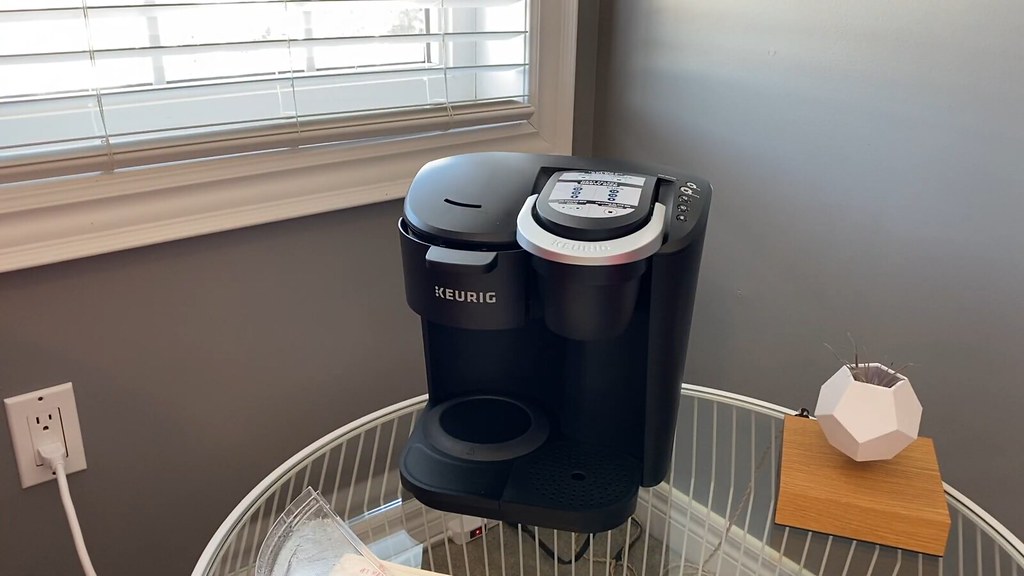Most people who buy Keurig machines do so for the convenience. With a Keurig coffee maker, you don’t need to know the science behind brewing coffee or how the machine works to make coffee every morning; you just put in a K-cup and hit brew. That’s why it’s extra annoying when your Keurig fails you and demands that you troubleshoot the issue.
One of the most common problems with Keurig machines is leaking when the unit is preheating. If you discover this issue with your Keurig coffee maker, then this is the guide for you! I’ll explain why this happens and how to fix the issue for good.

Why Your Keurig Machine Is Leaking During PreHeating
To understand why your Keurig coffee maker is leaking, it is helpful to understand a little about how your machine works.
When you put in your Keurig coffee pod and close the lid, a few needles pierce the plastic cup and foil cover. Between one and five needles —based on the model you have — pierce the top for hot water to enter the pod, and one needle pierces the bottom of the pod to allow brewed coffee to exit out into your cup.
Water flows through the upper needles into the grounds inside the pod and then eventually drips out the bottom hole and into your mug.
The only other thing you need to know is that Keurig uses a water pump to push water through the pod, whereas most drip coffee makers just let the expansion of heated water control how water moves through the machine. The added pressure coming through the top needle and into the K-cup can be the underlying issue.
Now that you know a little about how your Keurig machine works, I can explain the four primary reasons your machine might be leaking water during the preheating phase.
The Upper Gasket Is Broken or Misaligned
One of the most common reasons for Keurig machines leaking when preheating is a broken upper gasket. Since the Keurig coffee maker uses pressurized water to brew, the needle that punctures the foil on top of your coffee pod needs to create a seal with the foil to maintain the pressure. It does this using a silicone gasket that makes a seal with foil after it’s punctured.
If that upper gasket is misaligned or broken, then the pressure inside the pod will be lost, and some of the water being pumped out through the upper needle will leak out the top of the pod.
Since the water is leaking out before it reaches your coffee grounds, it will appear as though the Keurig machine is leaking during preheating. The water will travel down through the inside of the machine and leak out the bottom.
How Do You Fix a Broken Upper Gasket
In some cases, your upper gasket is just misaligned and not totally broken. You can inspect the casket by opening the lid of your Keurig machine and inspecting the rubber piece around the needle on the underside of the lid. If the seal is visibly shifted at all, seat it back into place using a pair of tweezers. If it’s cracked, missing, or fits loosely around the needle, you’ll need to replace it entirely.

Luckily, the upper gasket is a pretty simple component to replace. You can buy a replacement gasket on Amazon. The piece costs between $5 and $10 in most cases, which is a lot for something this size. However, Keurig doesn’t sell the piece on its own, so your only other option is to buy a new Keurig machine.
Once you have your replacement gasket, you can pry off the current one from the needle on the underside of the lid on your machine. I recommend using a pair of tweezers or another tool to avoid cutting your fingers on the needle. Once the old gasket is removed, you can slide on the new one using a pair of tweezers. Make sure the gasket is seated properly, or you’ll risk your machine leaking again when you go to use it.
You Might Have a Broken Hose Inside Your Machine
Another common cause of Keurig machines leaking during preheating is a broken hose or valve inside the machine. Remember, your Keurig machine pressurizes the water flowing into the coffee pod, and it does this using a water pump. The pump pushes water through one-way valves and a water hose from the water heating chamber to the needle that pierces the top of your coffee pod.
If the water hose or one of the valves in the water pump breaks or fails, water won’t travel to the pod as intended and will instead drip through your machine and come out the bottom.
How to Fix a Broken Hose or Valve Inside Your Keurig Machine
Unfortunately, replacing a hose or broken valve inside your Keurig coffee maker is a job that isn’t easy to do as a DIY fix. If you suspect that a broken valve or water hose is the underlying problem, I recommend you check to see if your machine is still under warranty. You can then contact customer support to see if you can get a resolution to your problem. If not, it might be best to buy a new Keurig machine.
Your Machine Is Clogged
Another common issue that leads to water leaking out of the bottom of your Keurig machine is a clog. Although K-cups are designed with a small filter inside, any issues with the filter sealing against the inner walls of the K-cup can lead to coffee grounds getting into the lower needle that pierces the bottom of the cup.
Plus, if you want to use a coffee grinder and grind your own coffee to upgrade your morning cup, the reusable filters can leak coffee grounds more easily, which could contribute to clogging. If that happens, the grounds can get clogged in there and prevent water from passing through.
Since you now know how your Keurig machine works, you know that if water doesn’t pass through the bottom hole in your K-cup, then it can back up to the upper holes and leak out the top. It can also leak out the bottom of the K-cup between the lower needle and the plastic.
If this happens, you’ll more likely see brown water or partially brewed coffee leak out the bottom of your machine.
How to Fix a Clogged Keurig Machine
Clearing a Keurig machine clog should be a pretty simple process. First, unplug the machine and set it down on a steady surface, like a countertop or table. Next, open the top hatch and remove the K-cup if there’s one in there. You should now be able to locate the two needles inside the chamber — one up top and one on the bottom.
Push a safety pin or a needle through the center of each of those needles. You can push it in and pull it out a few times to clear out any gunk that might have backed up in there.
Once you’re done, plug it back in and run the machine to look for clogging. You might have to repeat these steps a few times for a permanent fix.
You Have Scale Build-Up
Another potential issue that you might be running into is scale build-up. Tap water has minerals in it that build up inside all coffee machines. Over time, if you continuously ignore the “your machine needs descaling” notification like I do, the minerals will eventually build up to the point where they restrict water flow, which can cause the water to build up in the K-cup and come out the top.
How to Fix Scale Build-Up
Uh…this should be obvious: you stop ignoring the “your machine needs descaling” notification and actually descale your machine.
To do that, treat your water reservoir with a Keurig descaling solution or fill it with a 50/50 solution of water and white vinegar. Run the Keurig several times until the entire reservoir is empty. Fill the reservoir with just water, and run again until it’s empty.
You’ve Overfilled Your Water Reservoir
Probably the simplest issue you might be facing is also one of the easiest mistakes to make: overfilling the water reservoir without realizing it. Don’t feel bad…I’ve done this, too. If you put too much water in the reservoir, it could simply spill over the top when you reconnect it, and you might not realize that it leaks onto the counter until you go to make a cup of coffee. What seems like your Keurig machine leaking when preheating could actually be leaking long before that.
How to Fix an Overfilled Water Reservoir
Errr don’t do that. And if it’s too full and already leaking, it’s best just to run the machine once or twice to get the water level low enough to where it stops leaking. Simple as that.
How to Prevent Your Keurig Machine From Leaking During Preaheating
Fixing the issues above is usually pretty simple, although something like a broken hose inside your Keurig coffee machine is another story entirely. Ultimately, it’s easier to avoid leaking than it is to repair it after the fact in most cases.
Below, I’ll include a few handy tips for avoiding Keurig machine leaks to keep the coffee flowing and your frustration — and morning exhaustion — to a minimum.
Descale Your Keurig Machine Regularly
As tempting as it is to avoid descaling your machine, you legitimately will run into problems if you ignore the descaling prompts. It’s not expensive to do, and you don’t need to do it that often.
I suggest having some Keurig descaling solution on hand at all times and just listening to your machine. Regular descaling will not only help keep your needles and internal components clean and clear, but it will also help reduce unnecessary strain on the other components, like water pumps and heaters.
Replace Your Keurig Water Filters Every
You know those water filters that you replaced once in the beginning with the free filter included with your machine and then never replaced again? Yea, replace those!
The water filter in your Keurig machine can help remove some of those minerals that build up inside your Keurig coffee maker and cause clogs and eventual leaking. They can also remove physical debris from your water that could otherwise contribute to clogging and leaking.
Plus, filtered water makes coffee taste better. If I’m being totally honest, I actually don’t think this, and I tend to think unfiltered water actually tastes better. But a lot of people seem to agree that filtered equals better, so maybe you should listen to everyone else.
Clean Your Machine Regularly
Finally, make sure you clean your machine on a regular basis. I would suggest cleaning once every three months or so. You can follow our guide to cleaning a Keurig coffee machine, which will remove stray coffee grounds and any other debris that might contribute to clogging and leaking.

Wrapping Up: Keurig Leaking During Preheating
There you have it! By now, you should understand a little more about how your Keurig machine works, and you should have a good idea of how to assess a Keurig that’s leaking during the preheating process and how to fix your problem.
Here’s to some leak-free, coffee-heavy mornings in your future!
FAQ
Why does my Keurig leak water when preheating?
There are a few reasons, but the most common is a clogged needle. To fix this issue, unplug your machine, open the pod hatch, and locate the two needles inside. Use a safety pin or a needle to push through the center of both needles and scrape it along the inside to clear out any gunk. Be gentle, as a bent or broken needle can ruin your machine. Once you’re done, run water through two times.
How do you know if your Keurig is going bad?
There are a few signs that your Keurig coffee machine is on its way out. If you notice that your Keurig is taking longer and longer to brew a cup of coffee, if your coffee is more acidic or tastes sour, or if your Keurig is more than five years old, chances are it’s on its last legs. Leaking can also mean your Keurig machine is nearing the end of its life, although there are other reasons for leaking that can be fixed.
How do you unclog a Keurig needle?
To unclog the needles inside your Keurig machine, open the K-cup pod hatch, remove the K-cup inside, and locate the two needles inside the chamber. One should be up top on the hatch opening, and the other should be on the bottom of where you place your K-cup. Using a safety pin or another thin object to push through the hole in both needles and scrape out any gunk that is clinging to the sides. Run water through your machine twice, and voila! Fixed.


